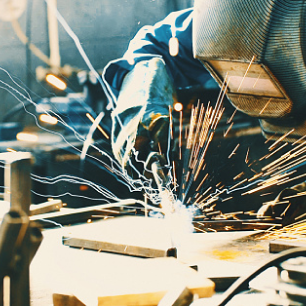Jump to:
Applications of Drones in Nondestructive Examination
Drones, also known as unmanned aerial vehicles (UAVs), have become valuable tools for nondestructive examination (NDE) of various structures thanks to their ability to access hard-to-reach areas, provide high-resolution imagery, and collect data safely and efficiently. This article offers an overview of typical drone applications in NDE, including advantages and examples.
Overview
Drones can safely and conveniently assist NDE functions, such as visual inspection, by capturing detailed images and videos of structures and allowing inspectors to assess surface conditions, corrosion, cracks, and other defects. Fitted with thermal cameras, drones can detect temperature variations, which may identify issues such as heat leaks, faulty electrical components, and insulation problems in buildings or industrial equipment supporting mechanical integrity programs. Light detection and ranging (LiDAR) equipped drones use laser technology to create 3D point clouds and digital elevation models, which are valuable for assessing the geometry and condition of structures and detecting deformations and settlements. Drones with sufficient payload can carry ultrasonic sensors to measure the thickness of materials and identify defects within them. This feature is commonly used to support the NDE of pipelines, tanks, and bridges. Drone-collected data can be processed through advanced software and analytics tools to create detailed reports, including 3D models, heat maps, and defect visualizations, facilitating more informed decision-making.
Drones can also be used to efficiently screen above-ground storage tanks during external inspections of tanks and containment area assessments in accordance with the American Petroleum Institute (API) Standard 653, Tank Inspection, Repair, Alteration, and Reconstruction, or the Steel Tank Institute/Steel Plate Fabricators Association (STI/SPFA) SP001, Standard for the Inspection of Aboveground Storage Tanks. From above, the drone can visually assess the boundaries of the containment area and screen the tank for containment area deficiencies, including large cracks in the concrete or liner tears. Similarly, the drones may be used to assess the general condition of the tank shell and roof — Fig. 1. Areas of paint breakdown and surface corrosion are accurately tracked, and a targeted visual inspection is performed based on the initial screening assessment of the tank farm.
Common Features of Drones Used in NDE
Drones used in NDE often have several standard features and capabilities designed to facilitate efficient and accurate inspections. The main feature is a high-
resolution camera, including visible light cameras, which capture detailed visual images and videos of the inspected structure. High-resolution drone cameras typically have a minimum of 12 megapixels (MP), but many models have 20 MP or higher. Higher megapixels result in sharper and more detailed images. The camera’s sensor size can affect image quality and low-light performance. Larger sensors generally capture more light and provide better image quality. Standard sensor sizes for drone cameras include 1/2.3-in., 1-in., and Advanced Photo System type-C (APS-C), which can vary slightly. NDE drone cameras often have fixed lenses designed for aerial photography. Depending on the camera’s intended use, the lens type may be wide-angle or zoom. The aperture size determines the amount of light that enters the camera. A lower f-stop number (e.g., f/2.8) indicates a larger aperture, which is better for low-light conditions. Some NDE drone cameras have adjustable apertures for greater control.
NDE drones often have autonomous flight capabilities, allowing them to follow preprogrammed flight paths or waypoints. This ensures consistent and repeatable data collection. Many modern NDE drones are equipped with obstacle avoidance sensors (e.g., LiDAR and ultrasonic) to detect and avoid obstacles in their flight path, enhancing safety and reducing the risk of collisions. NDE drones are designed for stability and may include advanced stabilization systems and wind-resistant capabilities, essential for maintaining image quality during inspections. Extended battery life is crucial for conducting lengthy inspections without frequent interruptions for recharging or battery swaps. Some drones come with swappable batteries for continuous operation. Drones used in NDE applications should be able to carry additional payloads such as sensors, cameras, or testing equipment. Payload capacity varies among different drone models. Many NDE drones offer real-time data transmission to a ground station or remote operator, allowing inspectors to monitor the inspection in progress and make immediate decisions based on the collected data. NDE drones are typically operated remotely using a dedicated controller or software interface, allowing inspectors complete control over the drone’s movements and data collection.
Application Examples
Drone NDE of Amusement Park Rollercoasters
Visual inspection of rollercoaster supporting steel structures is generally performed with extended-range man lifts and often uses rope access technicians. The process is discontinuous when using manlifts for amusement park NDE because the man lifts must be maneuvered from one location to another. Man lifts also do not provide 100% coverage around a supporting pipe column, and a single joint may be required to be inspected from two or three man lift positions to access the entire surface of a typical rollercoaster steel pipe column. The NDE inspection is a multiple-person job with a qualified operator and NDE technician on the platform and ground personnel for traffic control. Fall protection is required at all times during the inspection.
Drone NDE of rollercoasters permits the NDE inspector to assess the ride’s critical areas without needing a man lift. Cracked joints or suspected crack joints are noted and specified for further investigation using an NDE rope access team and an NDE team from a man lift. Significant cost savings can be achieved by using backup NDE inspection methods only for the targeted areas pinpointed by the drone NDE. Additionally, due to the difference in cost, the inspection frequency can be increased compared to NDE performed from a man lift or using a rope-access team. It should be noted, however, that supplemental inspection will almost always be required to support drone NDE to confirm findings.
Drone NDE of Remotely Located Agricultural Assets
Remotely located agricultural assets include steel storage tanks, fiberglass storage tanks, irrigation infrastructure, and other production-sustaining assets. In addition to being remotely located, access to these assets by land may be risky due to soil conditions. From a safety perspective, working at heights is generally not advisable if an accident occurs. Figure 2 shows a drone surveying and a 20,000-gal FRP tank farm for tank perpendicularity, bulging, coating condition, containment area, and shell integrity. The drone screens a tank farm cost-effectively and alerts the NDE inspector if more detailed inspections are required.
Conclusions
Drones allow the efficient screening of assets for deficiencies that may require a more detailed follow-up inspection. Drone NDE is a worthwhile financial investment that minimizes safety risks to the NDE technician and, in some cases, provides access to critical areas that may not be easily inspected.
Field inspection of welds is an access-driven process where traditional access is provided via boom lifts, scaffolding, and rope access. These access options come with significant costs and safety risks. While direct access to welds using the above methods will still be required in many cases, drone-assisted weld inspection can rapidly screen difficult-to-access areas and identify defects that require follow-up inspection. As a result, the cost and safety risks inherent to direct access methods can be reduced significantly.
Works Consulted
1. Morgenthal, G., and Hallermann, N. 2014. Quality assessment of unmanned aerial vehicle (UAV) based visual inspection of structures. Adv. Struct. Eng. 17: 289–302.
2. Ficapal, A., and Mutis, I. 2019. Framework for detecting, diagnosing, and evaluating thermal bridges using infrared thermography and unmanned aerial vehicles. Buildings 9: 179.
3. Wang, J., Sun, W., Shou, W., Wang, X., Wu, C., Chong, H. Y., Liu, Y., and Sun, C. 2015. Integrating BIM and LiDAR for real-time construction quality control. J. Intell. Robot. Syst. 79: 417–432.
4. Mattar, R. A., and Kalai, R. 2018. Development of a wall-sticking drone for non-destructive ultrasonic and corrosion testing. Drones 2: 8.
5. Hardin, P. J., and Jensen, R. R. 2011. Small-scale unmanned aerial vehicles in environmental remote sensing: Challenges and opportunities. GISci. Remote. Sens. 48: 99–111.
THOMAS R. HAY, PhD, P.E. (tomhay@techknowserv.com) is president of TechKnowServ Corp., State College, Pa. He is a licensed professional engineer and an ASNT Level III inspector.


